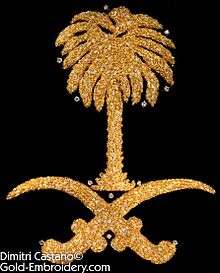Dimitri Vlachos - Castano
| Dimitri Vlachos - Castano | |
|---|---|
 I want to make the whole world sparkling | |
| Native name | Δημήτρης Βλάχος |
| Born |
Dimitrios Vlachos April 19, 1965 Cephalonia, Greece |
| Nationality | Greek |
| Known for | Goldwork embroidery |
| Spouse(s) | Maria Varouktsi |
| Website |
gold-embroidery |
Dimitri Vlachos - Castano (born 19 April 1965) is the only Greek Goldwork embroiderer of our times.[1] This last “Syrmakesis” uses real materials from gold and silver, as it is mentioned by M. George N. Ekaterinidis PhD, Former Director of Research Folklore Centre of the Academy of Athens and Secretary of Greek Folklore Company. He was born in Greece and comes from Cephalonia, son of Thanassis Vlachos, or as more widely known Kastanis (Castano), from Lixouri and Marietta Milla from Grizata, Sami. During his adolescence, he showed a special interest in gold smithery & silver smithery, which he practised for a long time. In 1994, Dimitrios Vlachos - Castano gets with the Art of Gold Embroidery.
Biography

In 1994, Dimitri Vlachos - Castano[2] met his compatriot by chance. Since then, he decided to devote his whole life to Goldwork. The cost was high since his passion for this art made him leave his business and sacrifice his personal life, even rest hours, in order to work for many years next to this man, his teacher of Goldwork embroidery. The method used by Dimitri Vlachos - Castano is identical to the method used by the first artist and inspirer of this art. The thin needle passes through the golden wire… it goes through the fabric in a surgical manner of unimaginable accuracy and realises the design that he had previously conceived himself. These smooth movements require excessive self-concentration.[3] Such movements are repeated a million times, but always with the same attention because even the tiniest mistake may fatally lead to the disaster of the entire prior creation even if it is the last stitch. This does not only happen because it is very hard to correct it but also because the original must be absolutely perfect and nothing less! The tiniest mistake costs not only in very expensive material but in many hours of painful and hard work and also immense Jobean patience.
Castano and recognition
.jpg)

His works have become famous all over the world after their uniqueness was shown on all large Greek and international television networks: CNN,[4][5] MEGA,[6][7] ALPHA,[8] are some of the media which brought out Goldwork and his rare works to the entire world. In 2003, the International TV Network CNN acknowledges Dimitrios Vlachos-Castano, after an exhaustive journalistic inquiry, as a unique artist in this field highlighting his important contribution in reviving Gold Embroidery. Moreover, his uniqueness lies in the fact that every gold-embroidered handicraft has a strictly unique design being always accompanied by the guarantees of the precious materials and the artist’s certification. Dimitrios Vlachos - Castano, has not limited himself to making exclusively priestly motifs. He has taken Goldwork much further without denying though the art of Goldwork embroidery. In experimenting with various designs, he illustrated his concerns on new avant-garde motifs. The source of his inspiration is mostly nature. He always seeks to create oeuvres that could be compared in the future in perfection and magnificence to those rare treasures of this Art that today are exhibited in Museums all over the world. He embroiders unique wedding and evening dresses, accessories, such as a pair of shoes, handbags, belts. Up to 2008, Dimitrios Vlachos-Castano signed his works as ΔΒ, which are the initials of his name in Greek. Since 2009, his artistic signature CASTANO adorns all his embroidered handicrafts.
History of the art
Gold embroidery, the most glorious form of Greek folklore art, the roots of which is found in Byzantium and is inspired by holy moments, creations of the most profound popular faith. The embroiderers,[9] they were called “syrmakésides”[10] in the past and were the artistic craftsmen of that era. They were also considered as “needle painters” and they illustrated the soul and faith of the people on priestly garments and imperial attire. Goldworks are of the few true works of art that were not altered throughout the centuries. Golden embroidered priestly garments and imperial attire are preserved and displayed until this day in various museums throughout the world as well as in sacristies of mostly orthodox convents. Unfortunately, however, in contrast with their amazing creations, the artists of the golden wire did not remain uninfluenced over time. Gradually, Goldwork embroiderers, especially during the Ottoman rule, began abandoning their craft.[11]
Very few of them continued practising this rare art. Fortunately, for Greek tradition, everyone can admire the endless hours of their work and fervour on their creations which have been saved from disasters and looting in various convents on Mount Athos and at the Patriarchate of Constantinople. They are the most precious part of the Greek cultural heritage and subject of study by art historians of the present. Most certainly they will continue to be studied by the historians of the future as well. Industrialisation, lack of resources and the pace of life in the nineteenth century constrained Goldwork. However, the necessity that old masterworks become approachable to craftsmen and especially to the public is still there. In the twentieth century, the only representative of this rare art is Greek: a man of intellect and art. His mother was from the coast of Asia Minor, Smyrna. His father was Ionian and, in particular, Cephaloniot. Fate made him transfer his knowledge to another highly esteemed Cephaloniot who inherited the honour as the vital responsibility for the continuation of this Greek traditional folklore art: Dimitrios Vlachos-Castano.
Tools
A pair of scissors, needles, awl, thimble and solid bee wax through which the silk thread passes which in its turn will fix on the fabric, against time, forever, the golden wire…! All this, however, are useless without the hands and the eyes of the creator, which are irreplaceable even from the most modern machines of today.
Materials and techniques

Golden wire, diamonds, pearls and other gemstones, all the priceless materials used, were passed through a particularly fragile needle during thousands of hours of work.[12] The artist would transform a simple fabric into an object of admiration and prestige. There are two ways of fastening the materials. The first is called “kavaliki” or “karfoto” (nailed), according to which the silk thread “straddles” incessantly the materials of the embroidery, from one to twelve clones giving to the one and only root various forms. The second is called the “krifi” or “krifo” (secret or hidden). In this case the material is fastened in such a way that gives the impression that it continues in the reverse side of the textile, although it doesn’t penetrate the fabric. In this hidden way of fastening are included the most beautiful roots, such as the “orthi” (proper), the “isia spasmeni”(straight broken), the “plagia” or “loxi” (oblique), the “vereriki”, the “kamares” (arches), the “kamarakia”, the “bakladota”, the “amigdalo” (almond), the “kotsakia” and the “kotsaki”.
Works
- “Fours Ribbons of the Episcopal candlesticks” (November 2014) Fours Ribbons of the Episcopal candlesticks of the Monastery of Doxiariou in Mount Athos. They are the largest and the most notable Episcopal candlesticks of the Catholic.
- “The Cross” (February 2014) The Cross of the Monastery of Doxiariou in Mount Athos. This is a copy of the most important metalworking relic of the Monastery used to accompany the troops in campaigns during the 9th century AD.
- “Altar Cover and Covers set of the Chalice Veil of Panagia Evangelistria of Tinos” (2007 - 2008)
- “Shrine” (2006) an ecclesiastical vestment bound to decorate the stand of the miraculous icon of Virgin Mary (Panagia Evangelistria) of Tinos.
- “Cover of The Sacred Relic of Saint Gerasimos of Cephalonia” (2005) Dimitrios Vlachos-Castano, after a pilgrimage to Saint Gerasimos, felt the need to dedicate something unique and as valuable as His grace, as a humble offer, to the Saint and protector of the island of Cephalonia.
- “Byzantine Cross” (January 2013) of omophorion
- “Byzantine Cross” (June 2012) of omophorion
- “Flag of the Kingdom of Saudi Arabia” (November 2010)
- “Gold Embroidered Pair of Shoes” (September 2010)
- “Holy Qur’an” (April 2010)
- “Gold Embroidered Raptor” (March 2010) painting of dimensions 100 cm x 144 cm
- “Emblem of the Kingdom of Saudi Arabia” June 2009
- “Gold Embroidered Arabic Invitation” October 2009
- “Gold Embroidered Purse and gold embroidered pair of shoes (Black Peep Toe)” (July 2009 - August 2009)
- “Fire wedding dress” (June 2009)
- “Olive wedding dress” (September 2008)

References
- ↑ George N. Ekaterinidis, Ph.D. Former Director of Research Folklore Centre of the Academy of Athens and Secretary of Greek Folklore Company
- ↑ [Dimitri Castano CV]
- ↑ Tsassis, Savvas (2005). Saint Gerasimos, 500 Years of Orthodoxy. Cephalonia.
- ↑ GoldEmbroidery (2009-07-21), Dimitri Castano - CNN World (June 2003) - Gold Embroiderer interview, retrieved 2017-04-24
- ↑ GoldEmbroidery (2009-07-21), Dimitri Castano - CNN World (March 2009) - Gold Embroiderer interview, retrieved 2017-04-24
- ↑ GoldEmbroidery (2009-07-21), Dimitri Castano - MegaTV (August 2007) - Gold Embroiderer interview, retrieved 2017-04-24
- ↑ GoldEmbroidery (2009-07-21), Dimitri Castano - MegaTV (August 2001) - Gold Embroiderer interview, retrieved 2017-04-24
- ↑ GoldEmbroidery (2009-07-09), Dimitri Castano - AlphaTV (September 2005) - Gold Embroiderer interview, retrieved 2017-04-24
- ↑ "Goldwork (embroidery)". Wikipedia. 2017-04-19.
- ↑ "συρμακέσης - Βικιλεξικό". el.wiktionary.org (in Greek). Retrieved 2017-04-24.
- ↑ Papadimitriou, Andreas (2004). Logos of Cephaloniots and Ithacans, 17th Year. Piraeus.
- ↑ Theohari, Maria (1996). Ecclesiastic Goldwork Embroidery. Athens: Apostoliki Diakonia of the Church of Greece.


